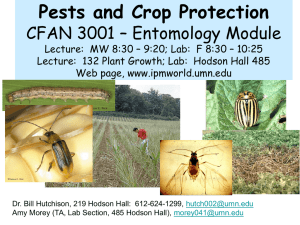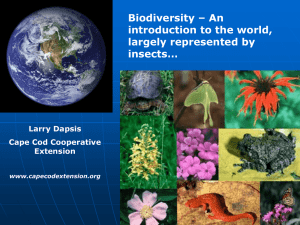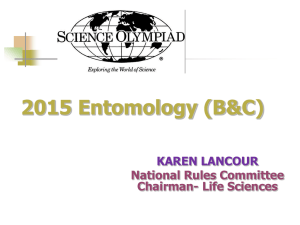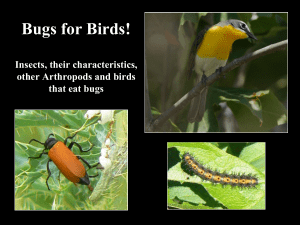ENTOMOLOGY(B,C)_HANDOUT_2014
advertisement
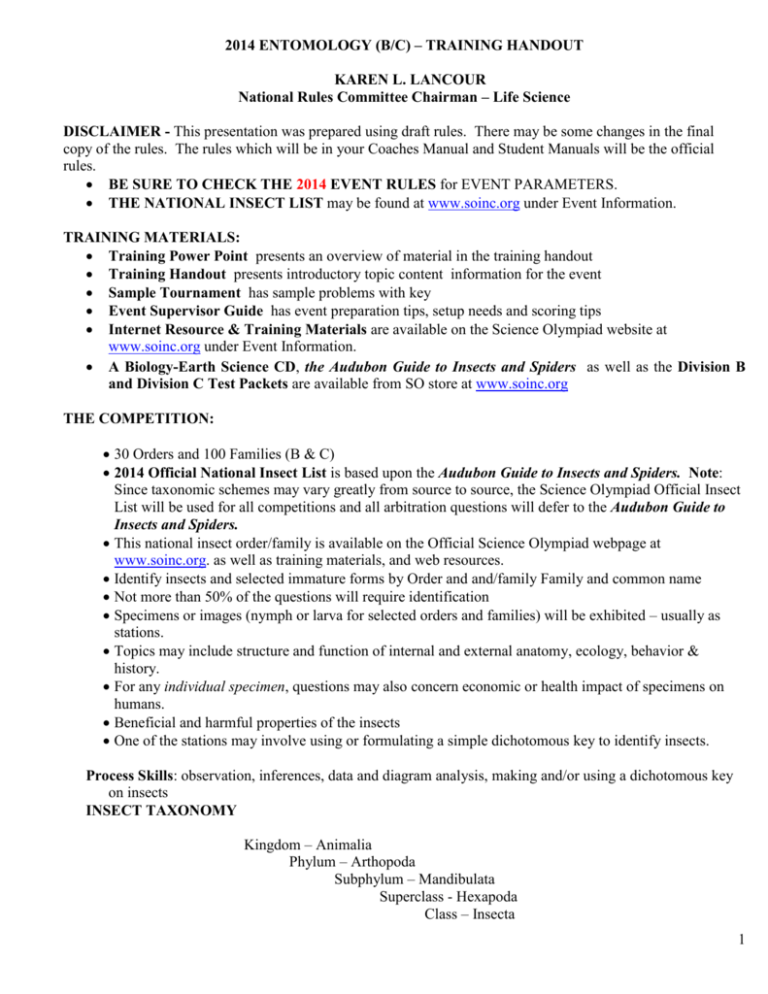
2014 ENTOMOLOGY (B/C) – TRAINING HANDOUT KAREN L. LANCOUR National Rules Committee Chairman – Life Science DISCLAIMER - This presentation was prepared using draft rules. There may be some changes in the final copy of the rules. The rules which will be in your Coaches Manual and Student Manuals will be the official rules. BE SURE TO CHECK THE 2014 EVENT RULES for EVENT PARAMETERS. THE NATIONAL INSECT LIST may be found at www.soinc.org under Event Information. TRAINING MATERIALS: Training Power Point presents an overview of material in the training handout Training Handout presents introductory topic content information for the event Sample Tournament has sample problems with key Event Supervisor Guide has event preparation tips, setup needs and scoring tips Internet Resource & Training Materials are available on the Science Olympiad website at www.soinc.org under Event Information. A Biology-Earth Science CD, the Audubon Guide to Insects and Spiders as well as the Division B and Division C Test Packets are available from SO store at www.soinc.org THE COMPETITION: 30 Orders and 100 Families (B & C) 2014 Official National Insect List is based upon the Audubon Guide to Insects and Spiders. Note: Since taxonomic schemes may vary greatly from source to source, the Science Olympiad Official Insect List will be used for all competitions and all arbitration questions will defer to the Audubon Guide to Insects and Spiders. This national insect order/family is available on the Official Science Olympiad webpage at www.soinc.org. as well as training materials, and web resources. Identify insects and selected immature forms by Order and and/family Family and common name Not more than 50% of the questions will require identification Specimens or images (nymph or larva for selected orders and families) will be exhibited – usually as stations. Topics may include structure and function of internal and external anatomy, ecology, behavior & history. For any individual specimen, questions may also concern economic or health impact of specimens on humans. Beneficial and harmful properties of the insects One of the stations may involve using or formulating a simple dichotomous key to identify insects. Process Skills: observation, inferences, data and diagram analysis, making and/or using a dichotomous key on insects INSECT TAXONOMY Kingdom – Animalia Phylum – Arthopoda Subphylum – Mandibulata Superclass - Hexapoda Class – Insecta 1 30 COMMON ORDERS OF INSECTS A. Protura (proturans) B. Collembola (springtails) C. Diplura (diplurans) D. Thysanura (silverfish) E. Ephemeroptera (mayflies) F. Odonata (dragonflies, damselflies) G. Blattodea (cockroaches) H. Mantodea (mantids) I. Isoptera (termites) J. Grylloblattodea (Ice Insect) K Dermaptera (earwigs) L. Plecoptera (stoneflies) M. Orthoptera (crickets, grasshoppers, katydids) N. Phasmatodea (walking sticks) O. Psocoptera (booklice & barklice) P. Mallophaga (chewing lice) Q. Anoplura (sucking lice) R. Thysanoptera (thrips) S. Hemiptera (true bugs) T. Homoptera (aphids, cicadas, hoppers) U. Megaloptera (dobsonflies) V. Neuroptera (lacewings, antlions) W. Coleoptera (beetles) X. Strepsiptera (Twisted-Wing Parasite) Y. Mecoptera (scorpionflies) Z. Siphonaptera (fleas) AA. Diptera (flies) BB. Trichoptera (caddisflies) CC. Lepidoptera (butterflies, moths) DD. Hymenoptera (ants, bees, wasps) EXTERNAL ANATOMY Segmented body divided into three sections: head, thorax, abdomen. Mouth including mandibles. Three pairs of legs attached to the thorax. One pair of antennae. External skeleton (exoskeleton) Usually, one or two pairs of wings attached to the thorax 2 EYES – Compound and Simple (Ocelli) MOUTH PARTS - Labrum, Labium, Mandible, Maxilla 3 Specialized for: Biting, Chewing, Sponging, Piercing, Sucking 4 WINGS Apterygota – adults like immature without wings Pterygota – adults have wings Exopterygota -the wings develop externally on the nymph body Endopterygote – wings develop inside of body in immature insects and not visible until adult immerges from pupa METAMORPHOSIS Ametabolous–Without Metamorphosis The insect resembles the adult, except that it is smaller. Sometimes called simple metamorphosis. Development involves increasing the insect's size by going through successive molts. Also Apterygota –adult like immature without wings Hemimetabolous – Incomplete Metamorphosis Egg, nymph, adult Also Exopterygota -winged insects, the wings develop externally on the nymph body Holometabolous–Complete Metamorphosis Egg, larva, pupa, adult Also Endopterygote – wings develop inside of body in immature insects and not visible until adult immerges from pupa 5 Orders - Ametabola & Apterygote Protura ( proturans, coneheads) Dipula (diplurans) Collembola (springtails) Thysanua (silverfish) Orders- Hemimetabola & Exopterygota Emphemeroptera (mayflies) Odonata (dragonflies, damselflies) Blattodea (cockroaches) Mantodea (mantids) Isoptera (termites) Grylloblattodea (Ice Insects) Dermaptera (earwigs) Plecoptera (stoneflies) Orthoptera (crickets, grasshoppers, katydids) Phasmatadea (walking sticks) Psocoptera (book and bark louse) Mallophaga (chewing lice) Anoplura (sucking lice) Thysanoptera (thrips) Hemiptera (true bugs) Homoptera (aphids, cicadas, hoppers) Orders-Holometabola & Endopterygota Megaloptera (dobsonflies ) Neuroptera (dobsonflies, lacewings, antlions) Coleoptera (beetles) Strepsiptera (twisted-wing parasite) Mecoptera (scorpionflies) Siphonaptera (fleas) Diptera (flies) Trichoptera (caddisflies) Lepidoptera (butterflies, moths) Hymenoptera (ants, bees, wasps 6 INSECT INTERNAL ANATOMY INSECT ECOLOGY: BENEFICIAL INSECTS: Pollination of many flowering plants Decomposition of organic materials Recycling of carbon, nitrogen, and other essential nutrients Control of populations of harmful invertebrates including other insects Direct production of foods as honey Manufacture of products as silk INSECT PESTS: Damage Crops Household Pests Parasites Biting and Stinging Insects Prey on domestic animals Eat human food, clothing & possessions Destroy trees, wood, paper DISEASE RELATED INSECTS: Mosquitoes – malaria, arboviral encephalitides, dengue fever, Rift Valley fever, West Nile encephalitis viral infection Ticks – Lyme disease, Rocky mountain spotted fever, tick typhus Fleas - plague Lice – lice infestation 7 Constructing A Dichotomous Key Four insects: a ladybug, a grasshopper, a dragonfly and a housefly. A. Start by observing the group of things to be used in the key. B. List the most general traits that can be used to divide the organisms into categories. C. Now, use your characteristics to fill in the Dichotomous Key below Dichotomous Key 1. go to 2 1. go to 3 2. 2. 3. 3. Notice that there were four organisms to be identified and it only takes three steps. There should be one less step than the total number of organisms to be identified in your dichotomous key. 8 TIPS FOR COLLECTING AND PRESERVING INSECTS Collecting: Most adult flying insects are generally collecting using a fine net. Individual insects can be collected with forceps by searching on plants, under logs and rocks and among weeds. Killing: Most entomologists use "killing jars" to kill the insects they have collected. A simple version of this is essentially a wide mouthed jar with a small open vial containing cotton attached to the lid. The cotton is saturated with fingernail polish remover which is relatively safe, but the killing jar should be labeled KILLING JAR--POISON. Specimens should be removed from killing jars as soon as possible and never more than a few hours. Insects can also be placed in vials or jars and placed in the freezer for several days. This will kill most insects although a few may revive when thawed. Mounting and Preserving: Most insects, unless very small or fleshy larvae, are best preserved by pinning and drying. Use only specially made insect pins to mount insects and pay attention to the location of the pin through the animal. Butterflies, moths and dragonflies will need to be spread on a pinning board to arrange their wings and legs and antennae. Very small insects may need to be attached with glue or nail polish to small triangles of stiff paper which are then inserted onto insect pins. If you are making a collecting of insects you must keep them in an insect proof box or tray. It is a good idea to place a moth ball in the box to prevent destruction by insects. See the detailed handout on collecting, killing and preserving insects PREPARING FOR COMPETITION Field Guide Study the organization of the field guide Study the information in the front of the field guide Become familiar with the organization of the color plates in the field guide Notice how the field guide organization is similar to the organization of the Official Insect List Put the page numbers of Orders and Families Information from the Audubon Guide to Insects and Spiders on the Official Insect List – it will save you a lot of time Tab the field guide with very small useful tabs so it is not cluttered and can be easily used Notice how the Order Characteristics come first and then the Family characteristics come Practice using the Field Guide to identify specimens or photos Practice under timed conditions to prepare for competition 9 Study Binder - Use the Binder to Help Learn the Insects !!!!!! The most effective resources are the ones produced by the students. The process of producing the resources is a major learning tool. Have a copy of the rules in your binder Have a copy of the lists (insects, birds, fossils if applicable) in your binder Prepare and organize materials by major topic divisions. Place materials from many different sources into your topic divisions Reduce the size of pictures where possible to get more information on a page. Color code information to help you locate or emphasize key items. Put pages in sheet protectors – two per protector to save space. Use tabs to separate sections. Label tabs so items can be located with ease. Power Point Slides - make power point slides for trees and use them so you can use them to study Flash Cards – make a set of flashcards with pictures on the front and information on the back Actual Specimens – collect and preserve actual specimens of insects – put data card with them so you can use them for study. Timer – prepare practice stations and use the timer to improve efficiency of your teamwork skills PREPARING RESOURCE PAGES TO TAKE INTO THE COMPETITION Learn the insects so resources will be used as little as possible. The most successful teams use very limited resources in competition. You will probably want to include the official insect list – put field guide page numbers on it to save time Place other notes that are not in the field guide Use notes for material you want to use that is not in the Field Guide or on the Official Insect List Check the event parameter so you know what is allowed in the competition. Since the events are timed, organization of materials is essential for the most effective use of the materials during the competition. Organize materials on each page to maximize available space Cut and paste items to organize materials more effectively on a page. Color code information to help you locate or emphasize key items. Use front and back of the page. Place the page in a protective sleeve or laminate it so it won’t get wet or damaged. 10 DOING THE COMPETION General Tips Insect specimens may look different from photo of an insect – the color & texture may change with drying. Be careful to protect actual specimens so they will not be damaged Try to identify the specimen to the Order and then decide what Family it is where needed Use common sense when answering non- identification questions Be careful to spell Order, Family and Common Names correctly Work as a team and use your teamwork skills to finish the requested tasks Answer Sheet Be sure to put your team name, team number, and individual team member names. Print information so it can be easily read and understood. Place answers in the appropriate place on the answer sheet. Be sure to put units after any measurements or calculations. Be sure answers to essay questions are organized and easy to read. Team work skills Use time effectively! Assign tasks and trust your partner’s skills. Keep on task and be sure to finish each part of the assigned question. Answering questions Carefully read all questions to determine exactly what is being asked. Take a moment to determine if your answer makes sense. Be certain that you have completely answered each question. Pay attention to details in the questions and in your answers. GOOD LUCK! Have fun and do your best. 11



